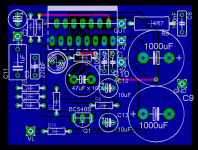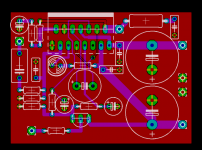Hello !
Here's a little Gift, it's a TDA7293 board designed on eagle.
It includes the created library on the zip file.
The board features the clipping indicator led, and a logical input to wake up the amp.
Attention, you MUST apply a signal in VL in order to make the amp play. If you don't want this, you can increase R10 to 10K value and connect it to +Vs.
The top routes (red) are jumpers.
Gain is 33, and there's a 2k2 / 22k divisor on the input, I did this way to avoid external oscilations.
It runs solid, no oscilations at all.
Press RASTNEST to show the common ground
I hope you enjoy it ! I would like to have feedback from the community.
Best Regards
Here's a little Gift, it's a TDA7293 board designed on eagle.
It includes the created library on the zip file.
The board features the clipping indicator led, and a logical input to wake up the amp.
Attention, you MUST apply a signal in VL in order to make the amp play. If you don't want this, you can increase R10 to 10K value and connect it to +Vs.
The top routes (red) are jumpers.
Gain is 33, and there's a 2k2 / 22k divisor on the input, I did this way to avoid external oscilations.
It runs solid, no oscilations at all.
Press RASTNEST to show the common ground
I hope you enjoy it ! I would like to have feedback from the community.
Best Regards

Attachments
Hi nando.
I don't mean to rain on your parade but the two decoupling caps right next to the power pins are all but useless because they are grounded so poorly.
If you went for a double sided board you could have at least used the top layer as a nice contiguous ground plane and saved some room for the other traces on the bottom layer.
I don't mean to rain on your parade but the two decoupling caps right next to the power pins are all but useless because they are grounded so poorly.
If you went for a double sided board you could have at least used the top layer as a nice contiguous ground plane and saved some room for the other traces on the bottom layer.
Yes hehe, but the board is HOME MADE 😀
No, the caps are grounded very nicely, as I connect the power supply GND between the caps, play attention on where is placed the GND wirepad.
No, the caps are grounded very nicely, as I connect the power supply GND between the caps, play attention on where is placed the GND wirepad.
Hi nando.
I'm talking about C6 and C7, the film caps. They are connected to the ground plane right above C12. Look at the path current has to take in order to go from the ground connection of the film caps back to the power supply ground between the large electrolytic caps. That is not good decoupling at all.
Your layout would be much better if you rotated C10 90 degrees clockwise, rotated C9 90 degrees counterclockwise, moved the V+ and V- through holes out to the edge of the board, and rotated C6 and C7 90 degrees counterclockwise so that there is a very short ground path between the ground of the electrolytic caps and the film caps.
I'm talking about C6 and C7, the film caps. They are connected to the ground plane right above C12. Look at the path current has to take in order to go from the ground connection of the film caps back to the power supply ground between the large electrolytic caps. That is not good decoupling at all.
Your layout would be much better if you rotated C10 90 degrees clockwise, rotated C9 90 degrees counterclockwise, moved the V+ and V- through holes out to the edge of the board, and rotated C6 and C7 90 degrees counterclockwise so that there is a very short ground path between the ground of the electrolytic caps and the film caps.
Brian, are you sure that a very low impedance ground is needed for these caps? As I know, they are only for decouple high impedance, so I thought that it would work fine this way. At least my amp runs without any oscilation, it's performing very well indeed, no noises or any problems.
Would you mind modifying the board layout to show your idea?
Your opinion is always wellcome. 😉
Would you mind modifying the board layout to show your idea?
Your opinion is always wellcome. 😉
Very nice amp, dead silent, the mute function works amazingly well, it's a pleasure at every power time, as it slowly increases the volume level untill get full volume (RC time). GREAT.
BUT... ONE chip doesn't handle easily +/- 40v @ 8 Ohms. It gets HOOOT, I'll parallel this latter, then it will be perfect. 😀
BUT... ONE chip doesn't handle easily +/- 40v @ 8 Ohms. It gets HOOOT, I'll parallel this latter, then it will be perfect. 😀
Thanks for the board Nando. I'd like to try this one out but I have one small question. When you speak of a signal on VL, do you mean a small voltage? If so, what voltage do you recomend? 5v?
-_nando-_ said:Brian, are you sure that a very low impedance ground is needed for these caps? As I know, they are only for decouple high impedance, so I thought that it would work fine this way.
Yes. The caps decouple high frequencies, not high impedance and the ground return path is every bit as important as the positive current path.
-_nando-_ said:Would you mind modifying the board layout to show your idea?
Attached is slightly modified version of your layout showing better placement for the power supply caps and better routing for the power supply traces. Since you were already using two layers I made the top layer ground. If I were making a PCB based on this chip, I would start the layout from scratch and begin laying out the power supply section first.
Download the file and change its name to "nando_mod.brd" so you can open it with Eagle.
Attachments
Very nice Brian. 🙂
I can vouch for the benefits of the two-sider with ground plain, and Brian's excellent eye for design detail.
I can vouch for the benefits of the two-sider with ground plain, and Brian's excellent eye for design detail.
- Status
- Not open for further replies.
- Home
- Amplifiers
- Chip Amps
- My GIFT for you: TDA7293 board + extras

